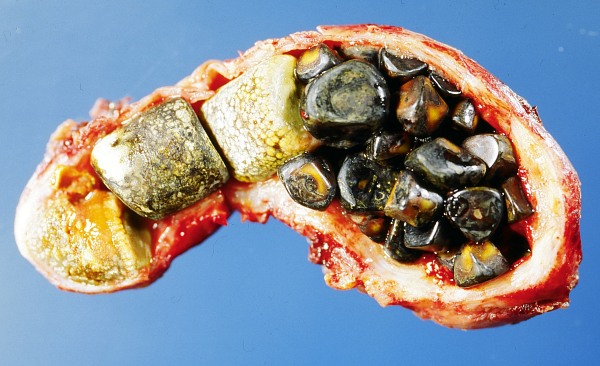Gallstone disease pathophysiology: Difference between revisions
| Line 66: | Line 66: | ||
==Microscopic Pathology== | ==Microscopic Pathology== | ||
[[Image:path89-05.jpg|thumb|200px|right|[[Gall bladder]] shows cholecystitis with cholelithiasis. Source: Duke University <ref name="urlweb.duke.edu">{{cite web |url=https://web.duke.edu/pathology/Week18/images/path89-05.jpg |title=web.duke.edu |format= |work= |accessdate=}}</ref> | |||
On microscopic histopathological analysis, variable evidences of inflammation can be noted transmurally including [[Neutrophil|neutrophils]], which are characteristic in gallstone disease.<ref>{{cite book | last = Fisher | first = M. M. | title = Gallstones | publisher = Springer US | location = Boston, MA | year = 1979 | isbn = 1461570662 }}</ref> | On microscopic histopathological analysis, variable evidences of inflammation can be noted transmurally including [[Neutrophil|neutrophils]], which are characteristic in gallstone disease.<ref>{{cite book | last = Fisher | first = M. M. | title = Gallstones | publisher = Springer US | location = Boston, MA | year = 1979 | isbn = 1461570662 }}</ref> | ||
Revision as of 15:07, 28 November 2017
| https://https://www.youtube.com/watch?v=UPw3ot1M_o0%7C350}} |
|
Gallstone disease Microchapters |
|
Diagnosis |
|---|
|
Treatment |
|
Surgery |
|
Case Studies |
|
Gallstone disease pathophysiology On the Web |
|
American Roentgen Ray Society Images of Gallstone disease pathophysiology |
|
Risk calculators and risk factors for Gallstone disease pathophysiology |
Editor-In-Chief: C. Michael Gibson, M.S., M.D. [1]; Associate Editor(s)-in-Chief: Hadeel Maksoud M.D.[2]
Overview
It has long been noted that gallbladder stone formation is associated with bile supersaturation, and this still remains the most common cause for gallstone formation.[1]
Pathophysiology

Pathogenesis[edit | edit source] The exact pathogenesis of [disease name] is not fully understood. OR
It is thought that [disease name] is the result of / is mediated by / is produced by / is caused by either [hypothesis 1], [hypothesis 2], or [hypothesis 3]. [Pathogen name] is usually transmitted via the [transmission route] route to the human host. Following transmission/ingestion, the [pathogen] uses the [entry site] to invade the [cell name] cell. [Disease or malignancy name] arises from [cell name]s, which are [cell type] cells that are normally involved in [function of cells]. The progression to [disease name] usually involves the [molecular pathway]. The pathophysiology of [disease/malignancy] depends on the histological subtype. Genetics[edit | edit source] [Disease name] is transmitted in [mode of genetic transmission] pattern. Genes involved in the pathogenesis of [disease name] include [gene1], [gene2], and [gene3]. The development of [disease name] is the result of multiple genetic mutations.
Associated Conditions
- Diabetes mellitus type 2
- Obesity
- Pregnancy
- Gallbladder cancer
- Gallbladder polyps
- Primary sclerosing cholangitis
- Porcelain gallbladder
- Rapid weight loss
- Constipation
- Eating fewer meals
- Low intake of:
On the other hand, wine and whole grain bread may decrease the risk of gallstones.[5]
Gross Pathology

On gross pathology, multiple small stones are commonly found or less commonly a solitary stone is seen. The smaller stones represent a higher morbidity since they can easily occlude the biliary tracts.[7]
Microscopic Pathology
[[Image:path89-05.jpg|thumb|200px|right|Gall bladder shows cholecystitis with cholelithiasis. Source: Duke University [8]
On microscopic histopathological analysis, variable evidences of inflammation can be noted transmurally including neutrophils, which are characteristic in gallstone disease.[9]
References
- ↑ Wang HH, Portincasa P, Wang DQ (2008). "Molecular pathophysiology and physical chemistry of cholesterol gallstones". Front. Biosci. 13: 401–23. PMID 17981556.
- ↑ name="urlFile:Gallensteine 2006 03 28.JPG - Wikimedia Commons">"File:Gallensteine 2006 03 28.JPG - Wikimedia Commons".
- ↑ Lv J, Yu C, Guo Y, Bian Z, Yang L, Chen Y, Li S, Huang Y, Fu Y, He P, Tang A, Chen J, Chen Z, Qi L, Li L (2017). "Gallstone Disease and the Risk of Type 2 Diabetes". Sci Rep. 7 (1): 15853. doi:10.1038/s41598-017-14801-2. PMID 29158491.
- ↑ R.M. Ortega (1997). "Differences in diet and food habits between patients with gallstones and controls". Journal of the American College of Nutrition. 16: 88–95. Unknown parameter
|month=ignored (help); Unknown parameter|coauthors=ignored (help);|access-date=requires|url=(help) - ↑ European Journal Gastroenterology & Hepatology. 6: 585–593. 1995. Unknown parameter
|month=ignored (help);|access-date=requires|url=(help) - ↑ "File:Gallensteine 2006 03 28.JPG - Wikimedia Commons".
- ↑ Ansert, Sandra (2018). Textbook of diagnostic sonography. St. Louis, MO: Elsevier. ISBN 978-0323353755.
- ↑ "web.duke.edu".
- ↑ Fisher, M. M. (1979). Gallstones. Boston, MA: Springer US. ISBN 1461570662.